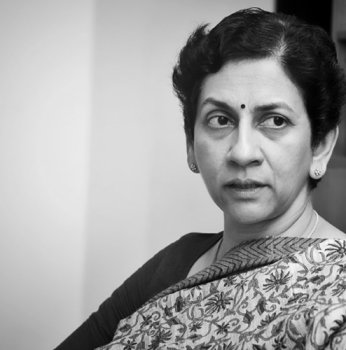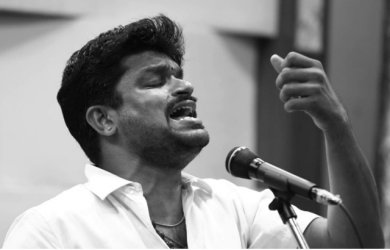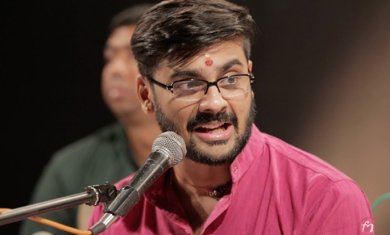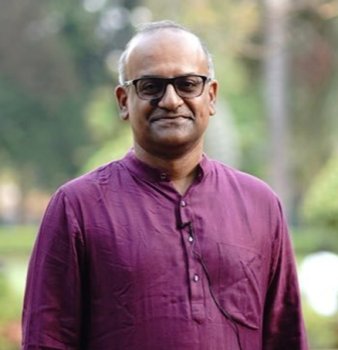
|   |

|   |
Musical Temples and Dancing Sculptures - Part 2 - Sandhya Shankar e-mail: sandhyashankaris@gmail.com May 8, 2022 Musical Temples and Dancing Sculptures - Part 1 Agni Kshetram In continuation with the series 'Musical Temples and Dancing Sculptures', the third kshetram was Thiruvannamalai, the Agni Kshetram. For many, Thiruvannamalai is synonymous with Bhagavan Ramana Maharishi and the magnificent Karthigai Deepam. Countless people go on the Girivalam (Parikrama) around the hill every full moon night with utmost devotion. I have also gone on this Girivalam once and it was certainly not an ordinary moonlight walk or an adventurous trek but a totally different experience.  Dr. Chitra Madhavan Watching this episode on this kshetram, I was left with not just more knowledge but a strange kind of fulfilment. This is only because no one other than Dr. Chitra Madhavan can make it so rich and informative that you feel that you have benefited more than you anticipated. She shares so many real, authenticated historical facts that have never been there in our history books or any guided tour can give. She discusses the sculptures of Thirugnansambandhar, Appar, Sundaramurthy Nayanar, Manickavasagar. Also, things like the anecdote about Arunagirinathar and his sister. I am not going to reveal more because I don't want to take away the interest if someone wants to watch it and also I would never do justice to Dr. Chitra's wonderful narration. Particularly, after she said that while all of us relate Chidambaram temple to Natya Shastra, an uninformed person will miss the beautiful sculptures depicting Natya Shastra in the Thiruvannamalai temple. I am definitely going there to see this temple with a new or should I say added perspective.  Kunnakudi Balamuralikrishna What can be better than listen to a soulful rendering of Muthuswami Dikshitar's composition "Arunachalanatham Smarami" in ragam Sharanga by one of my favourite singers Kunnakudi Balamuralikrishna after Dr. Chitra's rich narrative. Muthuswami Dikshitar visited Thiruvannamalai of such glory on his way from Kanchipuram to Tiruvarur. "Arunachalanatham" is one of his most important songs and celebrates the Tejolinga. It is clear when he makes special references to fire like the opening line refers to the Lord as 'Arunachalanatham'. 'Aruna' is associated with the light of the morning sun. The anupallavi says that the Lord is like a million suns at dawn (tarunadityakoti). The charanam says the deity is a radiant linga (tejomayalingam). It goes on to say that in his effulgent locks (swapradeepamauli) he holds Ganga and that his brightness excels that of the sun, the moon and fire (swaprakashajita somagnipatangam). Also, among the many meanings of the word 'Saranga' are two that are relevant to the kriti - camphor (easily inflammable) and light. Interestingly, the letter 'ra' refers to agni and there is a lot of usage of 'ra' throughout the song. I could go on and on about Dikshitar's profound lyrics but would like all those who are interested to see this episode and relish it for themselves. Jala Tatva Kshetram Anyone who is cynical or confused about the meaning of Hinduism and the need for innumerable Gods, countless temples, mythological stories connected with several temples, should just mull on the name of this Kshetram, especially the word 'Tatva.' That should explain a lot about the timeless philosophy. There is no paradise which is offered in Hinduism, no promised land waiting for us, just a journey in search of something difficult to explain, maybe it is called moksha or salvation which means self realisation, and by all means, to understand oneself is the most complicated thing. In this series of Panchaboothalinga Kshetrams, the journey has been an enriching and provoking one. Enriching because never would I have learnt so much about each of these Kshetrams if not for these series. Provoking because even if I have gone to all these 5 Kshetrams, I am now eager to go to all these temples once more with a new perspective, more interest, more knowledge and more maturity.  Ramakrishna Murthy I thank Ramya Ramnarayan to have conceptualised this treasure, where art, music, dance, history, sculptures, mythology, philosophy everything was brought to our homes in the most wholesome manner. Like my 80 year old mother, who is more loyal to Sun TV than Kalanidhi Marian himself, binge watched this with rapt attention! To listen to Ramakrishna Murthy's wonderful singing soaked in devotion with only the tanpura accompanying him was so soulful and somehow it made me feel closer to Lord Jambukeshwara at Thiruvanaikaval. I remember going to this temple every time I visited my paternal aunt who lived in Trichy. I remember listening to this Dikshitar's krithi "Jambupathe Mampahi" in ragam Yamunakalyani in so many concerts sung wonderfully by so many eminent singers but this experience was very different. There was absolutely no distraction as one could relish the lyrics and immerse oneself in the devotion with which it was written by the genius called Muthuswami Dikshitar. I am convinced that this experience was thus, because it was preceded by an extremely informative, valuable talk by V.Sriram. If anyone has attended his talks or his walks (which comes with talks), they will know that he is not only an engaging speaker but is so well read in almost everything and anything. It is not just history but his knowledge in Carnatic music prompts you to think that this must be his primary passion and we should be glad that we are also benefiting from his knowledge. Never a dull moment when he starts talking, and the entire talk was fascinating as always. I don't know how many people know that in that temple Goddess Akhilandeswari's earrings had Srichakram in it...I for one didn't know this till I listened to Sriram's wonderful talk. Neither did I know that 3 Nayanaars, Appar, Sundarar and Thirugnanasambandar visited this temple and sang about it. Oh yes! He mentioned Manickavachagar too! Also, how Adi Shankara has referred to this Goddess Akhilandeswari in his Soundarya Lahari. About the Chola kings, the Maratha king Shaji. His vivid description of the temple, and how the Goddess prays to Shiva in the form of water....isn't all this enough to make anyone curious to watch the entire episode? And towards the end the candid discussion between V.Sriram, Ramakrishna Murthy and Ramya Ramnarayan was so natural ....on the whole it was a fulfilling experience. Anyway, I am planning to make a trip to this Kshetram atleast to see the Srichakram earrings of the Goddess! Vayu Kshetram Every kshetram is important in this Panchaboothalinga kshetrams, as every krithi composed by Dikshitar is important and beautiful. Sri Kalahastisha is also known as the Vayu Kshetram, where Lord Shiva is worshipped in the form of air. In this episode the focus was on the sthala which pertains to Vayu or air and Dikshitar's composition "Sri Kalahastisha" in ragam Huseni is set to jhampa talam. What a beginning to the song with the name of the presiding deity like how in mega blockbuster film, the first scene opens with the entry of the superstar hero. That is half the job done. I mean, there are so many names to Lord Shiva, but Dikshitar chose to start with 'Sri Kalahastisha,' what a grand beginning. This program was conceived with the intention of bringing the importance and in-depth understanding of the sthala, krithi along with historical references and of course the Shaivite philosophy. About this sthala, Wikipedia will give all the information as to where it is located, like the Srikalahasti temple in the town of Srikalahasti is the only panchabhoota sthala outside Tamil Nadu. It is located in Andhra Pradesh 36 km from Tirupati.etc. So what is the value add for me when I watched this episode?  V. Sriram It was listening to V. Sriram share so much more than any Google or Wikipedia can offer. In fact he says, the Nayanaars don't mention Sri Kalahasti as a Vayu kshetram, so probably the sthala puranam came later. My opinion is that probably the Nayanaars were so steeped in devotion and their individual experience with Lord Shiva that they were above all these puranams and they had enough to share as it is without talking about the sthala puranam. Just a possibility, since their mission was to get closer to the Lord and nothing else mattered. I knew that this was the place where Kannappa Nayanaar was ready to offer both his eyes to cover blood flowing from the Shiva linga before Lord Shiva stopped him and granted him mukthi. But, until viewing this program, I didn't know that his original name was Thinna and much later Patinathaar (another devotee from the Chettiar community) has composed several verses where he mentions Kannappan's devotion to be matchless. Guess there is no rivalry or jealousy but only aspirations among true devotees! This temple is also associated with Rahu and Ketu of the navagrahas and is called the Kailash of the South or Dakshin Kailash (this is referred to in the song also). The Goddess has the snake (not sure if it is Rahu or Ketu) as a waist belt, maybe her way of controlling them. The Goddess here is Gnana Prasunambika Devi. There is also a composition to her called "Gnana Prasunambika" by Dikshitar in Kalyani. There is a lamp inside the inner sanctum that is constantly flickering despite the lack of air movement inside. The air-linga can be observed to move even when the priests close off the entrance to the main deity room, which does not have any windows. One can see the flames on several ghee lamps flicker as if blown by moving air. Hence it is proved that there is the presence of air, presence of God. The main linga is untouched by human hands, even by the priest. Abhisheka (bathing) is done by pouring a mixture of water, milk, camphor, and panchamrita, sandal paste, flowers and the sacred thread are offered to the utsava-murti, not the main linga. Srikalahasti is named after three devotees of Shiva - Sri (spider), Kala (snake) and Hasti (elephant). This story behind this has already been referred to in the jambupathe krithi. It is fascinating that there is importance given to something like a spider. A lesson for us, that no one is insignificant (like the squirrels helping Lord Rama to build the bridge). I have been to this temple years ago, and have seen the Goddess leaning slightly to listen to the Pranava Mantram uttered by Lord Shiva. But, it was only after watching this program, I knew that Nakeeran (remember that old guy in the film 'Thiruvilayadal' who finds fault with Sivaji Ganesan, sorry, Lord Shiva's poetry) wrote some 100 verses about Sri Kalahastisha. What followed was Ramakrishna Murthy's soulful rendering of Dikshitar's krithi "Sri Kalahastisha" in ragam Huseini. Moving on to the composition, Dikshitar in his usual style embellishes this krithi with such wonderful play with the grammar and the language that one can only admire the genius at work and enjoy the brilliance. He steps it up stone by stone as he moves through the composition. In the pallavi, he clearly sets the context, the location and the Vayu linga reference. In the anupallavi, he describes the esoteric significance of the temple and in the process, beautifully weaving in the raga mudra. Finally, in the charanam, he makes references to the temple folklore, the Lord's consort, some more interesting play with the words and finishes off with the mention of the great devotee Kalappanaickenpatti Nayanaar. All this while the composition smoothly flows along in jhumpa talam. Ramakrishna Murthy sang in his typical clear and succinct way. Dikshitar never uses the term Vayu linga in the kriti even though he refers to the primordial elements on quite a few occasions. I suppose this is where Dikshitar's stature as a grammatical genius comes forth. He uses the word 'samira' for 'wind' to preserve the Adyakshara Prasam in the Pallavi. The lilting voice is so soothing that it caresses the listener like a peacock feather. Dikshitar's lyrics itself makes the pallavi a strong decoction with the full flavor of Huseini on display. Ramakrishna Murthy understands all of this and doesn't even attempt to deviate a bit, keeping the beauty of this krithi intact. The panel discussion that followed was interesting and a worthy watch. I feel initiatives such as these series will be useful to devotees, artistes, academicians, and rasikas such as me.  Sandhya Shankar belongs to a respected business family in Chennai. She is a Life Skills & Corporate Trainer by profession. An avid reader, she has written several poems and articles. She has keen interest in all art forms and has explored many different forms of painting like stained glass and Tanjore being among them. She is a trained musician. Her witty reviews have gained a loyal and interactive readership. |